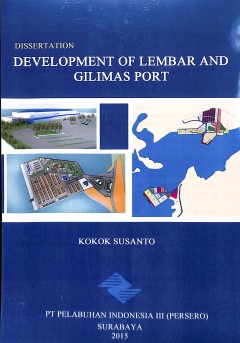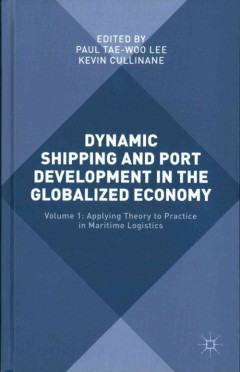Ditapis dengan

Port Development
- Edisi
- -
- ISBN/ISSN
- 92-1-1-112160-4
- Deskripsi Fisik
- 227 p
- Judul Seri
- -
- No. Panggil
- TXT SC GEV p
- Edisi
- -
- ISBN/ISSN
- 92-1-1-112160-4
- Deskripsi Fisik
- 227 p
- Judul Seri
- -
- No. Panggil
- TXT SC GEV p

Development of Lembar and Gilimas port
This research resulted Result of economic analysis using payback period shows the development of Gilimas Port need 7 years and 7 moths in optimistic scenario, 8 years and 7 moths for moderate and 9 years for pessimistic scenario. Result of economic analysis by using interest rate return (IRR) shows that for Gilimas port the value of IRR is bigger than the interest, so whether optimistic, m…
- Edisi
- -
- ISBN/ISSN
- -
- Deskripsi Fisik
- 33 p.,; illus : 30 cm ; chart; pictures ;
- Judul Seri
- -
- No. Panggil
- TD PO SUS d

Optimal investment priority in container port development
The aim of this paper is to develop realistic and relevant investment planning models for inland container transportation systems. The models may be utilized to identify the most eOEective investment plan for inland transportation infrastructure development and to evaluate the inland container transportation system. The procedure enables determination of the optimal locations, sizes and time of…
- Edisi
- VOL. 28, NO. 2, 109± 123
- ISBN/ISSN
- 1464± 5254
- Deskripsi Fisik
- 17 p.
- Judul Seri
- Maritime Policy & Management: The flagship journal of international shipping and port research
- No. Panggil
- ATC LO KOH o

Assessing the Environmental Impact of Maritime Operations in Ports: A Systems…
This chapter presents a framework which is accessible to port authorities to assess the potential environmental impact of maritime operations. Pursuant on globalisation, increased numbers of shipmovements have generatedmore frequent routine maritime operations in ports but few formal approaches exist for assessing their environmental impact, which potentially could be significant. In a novel f…
- Edisi
- 2012
- ISBN/ISSN
- 978-1-78052-340-8
- Deskripsi Fisik
- 25P
- Judul Seri
- Maritime Logistics
- No. Panggil
- ATC LO DIN a

Container Liner Shipping, Port Development and Competition
This chapter reviews and analyses the contemporary development of liner shipping, port development and competition. It begins with a comprehensive review on the latest developmental trends of liner shipping and business strategies, as well as their impacts on port development and competition. Then, it discusses the responses of ports, past, present and (likely) future, in addressing these new d…
- Edisi
- Vol. 13 Iss 4 pp. 401-446
- ISBN/ISSN
- 978-1-78052-340-8
- Deskripsi Fisik
- 27P
- Judul Seri
- Maritime Logistics
- No. Panggil
- ATC LO YNG c
Securitizatoin challenges on infrastructure assets
- Edisi
- Innovative Financing for Development and Growth
- ISBN/ISSN
- -
- Deskripsi Fisik
- 22 pages
- Judul Seri
- -
- No. Panggil
- PPT PO ELV s
- Edisi
- Innovative Financing for Development and Growth
- ISBN/ISSN
- -
- Deskripsi Fisik
- 22 pages
- Judul Seri
- -
- No. Panggil
- PPT PO ELV s

Container liner shipping, port development and competition
This chapter reviews and analyses the contemporary development of liner shipping, port development and competition. It begins with a comprehensive review on the latest developmental trends of liner shipping and business strategies, as well as their impacts on port development and competition. Then, it discusses the responses of ports, past, present and (likely) future, in addressing these new d…
- Edisi
- Vol. 13 Iss 4 pp. 401-446
- ISBN/ISSN
- 978-1-78052-340-8
- Deskripsi Fisik
- 27 p.
- Judul Seri
- Maritime Logistics
- No. Panggil
- ATC LO ADO c
Maritime-Port Technology and Development
We are pleased to host the International Maritime and Port Technology and Development Conference in Trondheim, Norway, in 2014. This conference has served in the past as an important and internationally recognised platform to disseminate the latest research results in the field of Maritime and Port Technology and Development with strong contributions in the field of efficiency and reliability o…
- Edisi
- -
- ISBN/ISSN
- 978-1-315-73162-9
- Deskripsi Fisik
- vii, 240 p
- Judul Seri
- -
- No. Panggil
- TXT PO EHL m
Revew Maritime Transpot 2012
- Edisi
- -
- ISBN/ISSN
- 978-92-1-055950-8
- Deskripsi Fisik
- xiv, 176 p
- Judul Seri
- -
- No. Panggil
- TXT MR UNI r
- Edisi
- -
- ISBN/ISSN
- 978-92-1-055950-8
- Deskripsi Fisik
- xiv, 176 p
- Judul Seri
- -
- No. Panggil
- TXT MR UNI r
Review of Maritime Transport 2013
- Edisi
- -
- ISBN/ISSN
- 978-92-1-054195-4
- Deskripsi Fisik
- xii, 184 p
- Judul Seri
- -
- No. Panggil
- TXT MR UNI r
- Edisi
- -
- ISBN/ISSN
- 978-92-1-054195-4
- Deskripsi Fisik
- xii, 184 p
- Judul Seri
- -
- No. Panggil
- TXT MR UNI r

Port development: from gateways to logistics hubs
Since the UNCTAD three generation port development model was proposed in 1990, changes in technology, working practices and the commercial environment have led to tighter and more sophisticated linkages between service providers, facilitators, operators and end customers. This was explored in more detail in the WORKPORT model which highlighted the way in which ports and the services they provid…
- Edisi
- VOL. 36, NO. 3, 253–267
- ISBN/ISSN
- 0308-8839
- Deskripsi Fisik
- 16 p.
- Judul Seri
- -
- No. Panggil
- ATC PO PET p
Perencanaan pelabuhan
- Edisi
- -
- ISBN/ISSN
- 979-8541-04-9
- Deskripsi Fisik
- xi, 248 p
- Judul Seri
- -
- No. Panggil
- TXT PO TRI p
- Edisi
- -
- ISBN/ISSN
- 979-8541-04-9
- Deskripsi Fisik
- xi, 248 p
- Judul Seri
- -
- No. Panggil
- TXT PO TRI p
Dynamic shipping and port development in the globalized economy volume 2: eme…
This book comprises two volumes, both containing chapters which have been personally invited by the editors. As such, the editors of this book wish to profoundly thank all the contributors for accepting the invitation and for submitting their insightful works in accordance with the publishing deadlines and as specified in the book proposal. Professor Paul Tae-Woo Lee would like to express his s…
- Edisi
- volume 2
- ISBN/ISSN
- 978–1–137–51427–1
- Deskripsi Fisik
- xvi, 222 p.
- Judul Seri
- -
- No. Panggil
- TXT PO LEE d

Dynamic Shipping and Port Development in the Globalized Economy
This book comprises two volumes, both containing chapters which have been personally invited by the editors. As such, the editors of this book wish to profoundly thank all the contributors for accepting the invitation and for submitting their insightful works in accordance with the publishing deadlines and as specified in the book proposal. Professor Paul Tae-Woo Lee expresses his sincere grati…
- Edisi
- Volume 1
- ISBN/ISSN
- 978-1-137-51429-5
- Deskripsi Fisik
- xv, 231 p
- Judul Seri
- -
- No. Panggil
- TXT PO LEE d

Institutional reforms of port authorities in the Netherlands; the establishme…
In this paperwe argue that much of the literature on port governance takes the embeddedness of the port authority in the public sector as a given, whereas we argue that port development is intrinsically commercial and it is thus appropriate to regard a port authority as a port development company. In line with this, we provide a critique of the term ‘port authority’. Next, we describe the c…
- Edisi
- -
- ISBN/ISSN
- -
- Deskripsi Fisik
- 6 p .
- Judul Seri
- -
- No. Panggil
- ATC PO LUG i

Competition and collaboration among container ports
The development of new ports in China and the enhancement of port facilities in Korea will force major Japanese ports, which were the region’s hub ports until the 1980s, to become local feeder ports for entry into East Asia. To consider the integration of cargo flow and liner networks, such Japanese ports need to collaborate with each other rather than compete with neighboring ports on an ind…
- Edisi
- Volume 26 Number 1
- ISBN/ISSN
- 2092-5212
- Deskripsi Fisik
- 18 p.
- Judul Seri
- -
- No. Panggil
- ATC PO HOS c

Cargo flow and transit impacts on port development
The article analyses the changes of cargo flow structures, the distribution by overseas regions and their potential impact on port development. The analysis on how the cargo type and transit regions influence on the vessel capacity has been carried out. A view on the general range of ship size employed on the Baltic is given. The potential of the Klaipeda seaport is approached in respect of cer…
- Edisi
- -
- ISBN/ISSN
- 1648-4142
- Deskripsi Fisik
- 5 p.
- Judul Seri
- Transport
- No. Panggil
- ATC PO PAU c

Port development: from gateways to logistics hubs
Since the UNCTAD three generation port development model was proposed in 1990, changes in technology, working practices and the commercial environment have led to tighter and more sophisticated linkages between service providers, facilitators, operators and end customers. This was explored in more detail in the WORKPORT model which highlighted the way in which ports and the services they provi…
- Edisi
- VOL. 36, NO. 3, 253–267
- ISBN/ISSN
- -
- Deskripsi Fisik
- 16 p .
- Judul Seri
- Maritime Policy & Management: The flagship journal of international shipping and port research
- No. Panggil
- ATC LO BER p
 Karya Umum
Karya Umum  Filsafat
Filsafat  Agama
Agama  Ilmu-ilmu Sosial
Ilmu-ilmu Sosial  Bahasa
Bahasa  Ilmu-ilmu Murni
Ilmu-ilmu Murni  Ilmu-ilmu Terapan
Ilmu-ilmu Terapan  Kesenian, Hiburan, dan Olahraga
Kesenian, Hiburan, dan Olahraga  Kesusastraan
Kesusastraan  Geografi dan Sejarah
Geografi dan Sejarah